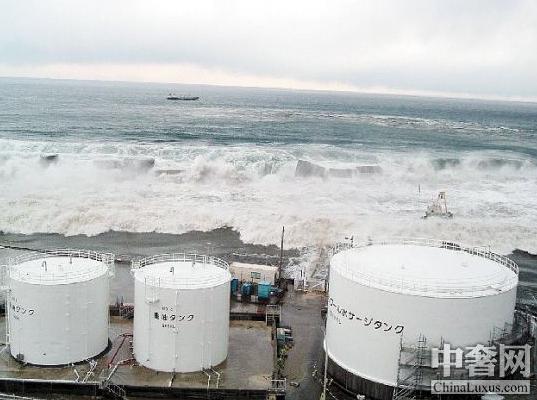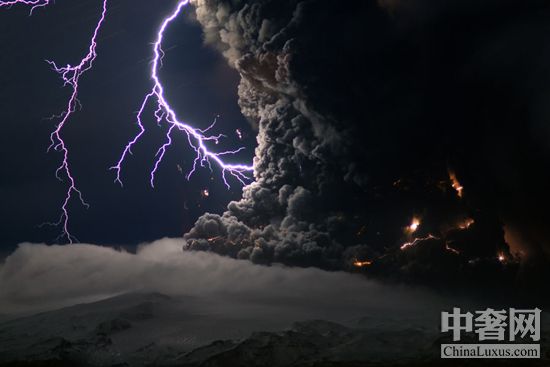The "3.11" earthquake in Japan has been over for more than a year, but its enormous destructive power is still fresh in its memory. The terrible tsunami that accompanies the major earthquake has caused shocking scenes that show that nature is amazing the power of. But do you know how powerful they are? Can science and technology destroy the power of these natures as magic? Tsunami Tsunami contains energy equivalent to 6.9 million barrels of crude oil in 1000 seconds On March 11, 2011, a huge water wall was advanced to Miyako in the northeast region of Iwate Prefecture, Japan. The massive tsunami triggered by a large earthquake that occurred about 80 miles (129 kilometers) east of the city in Sendai, Japan, completely destroyed many cities on the eastern coast of this island nation. According to geophysical fluid dynamics expert Susan Keefer, a geologist at the University of Illinois, the energy released by the tsunami actually far surpasses the destructive power of the atomic bombs that bombed Hiroshima and Nagasaki in 1945. The energy contained in this tsunami may also exceed the energy released by the exploding explosion of one megaton of yellow explosives, equivalent to approximately 28 times the total energy of two atomic bombs that bombed Japan. But Kieferer said that perhaps it is more destructive, perhaps 10 megatons or 280 times the amount of energy released by two atomic bombs. This difference mainly depends on how long the tsunami lasts. According to her estimates, the tsunami lasts between 100 and 1000 seconds. At the highest limit, the energy contained in the tsunami is equivalent to 6.9 million barrels of crude oil, or 50% of the total oil consumed in Japan every day. The results of this assessment also take into account the speed of the waves. According to Kifer, the speed of the waves is about 220 meters per second and reaches the shoreline in 30 minutes. She uses waves to estimate the open sea height of 7 meters, and estimates that the length of the waves is about 800 miles (1300 kilometers), or equivalent to half the length of the coastline of Honshu Island. earthquake Japan's "3·11" Earthquake Generates Energy to Meet 4 Days of Global Oil Consumption On March 14, 2011, in Nodamura, Iwate Prefecture, northern Japan, rescue workers wearing orange uniforms are looking for the remains of the victims in the ruins. According to scientists of the U.S. Geological Survey, in order to trigger a tsunami that would destroy Iwate Prefecture and the east coast of Japan, an earthquake that occurred three days ago in the northeast Pacific needs at least 475 megatons of TNT. This energy is equivalent to 326 million barrels of crude oil, to meet the world's four days of oil demand. With the help of instruments, scientists only measure the energy released by a few natural phenomena, including earthquakes. The data obtained by the seismograph can help scientists assess the terrible energy released by the earthquake to tear the ground surface and shake the nearby and distant buildings. However, the instrument does not depict a complete seismic energy image, and some of the energy is dissipated by the heat generated by the friction. The magnitude of the earthquake that occurred in Japan in 2011 reached level 9, which is one of the most serious earthquakes in Japan and it is also one of the largest earthquakes ever measured. Waves The annual energy of Pacific waves is about 1/3 of the annual current demand of the United States. An analysis by the American Electric Power Research Institute found that waves that constantly impact the continental shelf of the Pacific coast of Alaska contain 1,360 TWh of energy per year. This is equivalent to 40% of Japan's annual current output, which is approximately one-third of the current demand in the United States. Alaska's Pacific coastline has more available wave energy than all other US coastlines. This is because it is the largest coastline in the United States, extending from the Aleutian Islands to the Prince of Wales (click to watch the prince film and television work "Qianmen 2") and its narrow strips. But in addition to this, Alaska's offshore areas can also obtain energy because this area of ​​ocean is known by oceanographers as "waves." Waves formed by the sea breeze in open water continue to slap the last frontier of the United States. Of course, it is not easy to capture all the energy. The independent non-profit organization, the American Electric Power Research Institute, analyzed the amount of energy that can be captured technically based on current design conditions. They carried out this research work using a floating or buoy system, using ocean rising surge, down driven hydraulic pumps. If the waves are too intense or too weak, these devices will not work, and they need to be placed in the most reasonable position. But Paul Jacobson, the hydraulic project manager at the Electric Power Research Institute in the United States, pointed out that the energy that can be captured technically is not necessarily the “real†catchable energy. Many areas may be areas where future wave energy projects are prohibited because they are not sea routes, fishing areas, or because the environment is very fragile, or the marine life of the area may be destroyed by wave energy harvesters or their moorings. . How to submerge and install power lines and transfer the energy collected from the ocean is also very important for people to use. volcanic The heat released by the Io “Io†volcano is 78 times that of all U.S. power stations. On April 16, 2010, the Eyjafjallajokull volcano in southern Iceland was erupting, and the ash cloud spewed out to cover the sky. Volcanic eruptions mark the escape of heat inside the Earth. Geothermal energy also emerges from the surface in the form of volcanic eruptions, but no one knows how to safely use this form of geothermal energy. Ashley Davis, a volcanologist at NASA's Jet Propulsion Laboratory in Pasadena, California, stated that in March 2010, the first two eruptions of the Eyjafjallajokull volcano produced thermal radiation. It quickly soared to 1 billion watts, and then to a peak of 6 billion watts. In fact, 6 billion watts is only a small part of the total amount of heat released by Eyjafjallajokull volcano in 2010. It does not cover the mechanical energy released by the earthquakes and explosions that accompanied the volcanic eruption or the heat of the lava that was ejected. . Davies pointed out that compared with other volcanoes on other planets, the volcanoes on Earth can only be small and powerful. Take the example of a volcano on the Io “Ioâ€. The volcano erupted in 2001, releasing an amazing 78 terawatts of heat, which is 78 times the installed capacity of all power stations in the United States. The energy released in one hour is equivalent to about 46 million barrels of crude oil, which is about half of the global total daily consumption. At present, geothermal energy has become a more and more concerned energy source. In Iceland, almost all buildings and hot water facilities use geothermal energy, and the amount of geothermal energy generated accounts for about 1/3 of Iceland’s total electricity generation. lightning Lightning is enough to meet the electricity demand of ordinary families from 9 days to 1 month Lightning is the nature "power show" we are most familiar with. It is estimated that the number of times the Earth was struck by lightning hits 45 times per second. Lightning expert Don McGregor of the National Oceanic and Atmospheric Administration of the United States stated that lightning is an atmospheric discharge phenomenon and the released energy is between 100 megajoules and 30,000 megajoules, usually between 1,000 megajoules and 5,000 megajoules. between. In the sci-fi film Back to the Future, Dr. Emmett Brown used lightning to drive the time-travelled car he invented and sent the hero to the past. In the real world, although lightning does not help us realize the dream of time travel, the energy generated is enough to make an average American passenger car travel about 180 to 910 miles (about 290 to 1,450 kilometers), which is equivalent to 8 to 38 gallons. (About 30 to 144 liters) The energy produced by gasoline. In the film, Dr. Brown said that the amount of lightning electricity is enough to meet the electricity demand of ordinary American families for about 9 days to 1 month. The reason why the range of lightning energy is so great lies in its own complexity. Lightning initially formed in the clouds and then hit the ground through a channel. Lightning strikes on contact with the ground. Inrush current returns along the channel. During this process, most of the energy is transferred to the ground. The lightning that the human eye sees is actually composed of multiple lightnings and lasts for nearly half a second. If the gap between each lightning is large enough, lightning flashes. Although being struck by lightning is lethal, the energy of lightning is negligible compared to other natural disasters that are enough to level the entire city and destroy the coastline. On March 11, 2011, a 9-magnitude earthquake in northeastern Japan triggered a tsunami, which is a terrifying example of nature's display of power. At present, scientists are trying to measure the energy of volcanoes, wildfires, hurricanes and tsunami. Compared with these natural disasters, the use of geothermal energy, wind energy and solar energy by humans is not worth mentioning. It is only a very small part of natural energy. Stainless Steel Coil,Cold Rolled Stainless Steel Coil,Mirror Stainless Steel Coil Ecurity Fence,Stainless Steel Pipe Co., Ltd. , http://www.zjsteeltube.com
